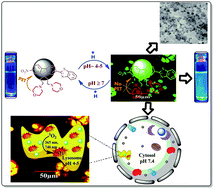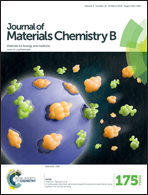Fluorene–morpholine-based organic nanoparticles: lysosome-targeted pH-triggered two-photon photodynamic therapy with fluorescence switch on–off†
Abstract
Nanocarrier-mediated photodynamic therapy (PDT) is an effective tool for anti-tumour treatment due to the targeted and image-guided delivery of photosensitizers (PSs) to diseased tissues. These nanocarriers range from inorganic, ceramic, polymeric to biological nanoparticles (NPs). Such PS-grafted bicomponent nanocarriers have limitations like (i) difficulty in surface modification, (ii) lower loading percentages of the therapeutic agent, (iii) unstable physical encapsulation, etc. By any means, if we can prepare PSs directly as NPs then we can surpass the above drawbacks. Hence, we synthesised new two-photon fluorene–functionalised morpholine (Fluo–Mor)-based organic NPs that showed strong fluorescence and profound photodynamic therapy (PDT) activity only in acidic medium. Such a pH-responsive appearance of fluorescence enables Fluo–Mor NPs for the real time monitoring of photodynamic therapeutic activity selectively in low-pH organelles viz. lysosome. Cytotoxicity of Fluo–Mor NPs was monitored using time-dependent and dose-dependent cancer cell viability assay and confocal imaging.


 Please wait while we load your content...
Please wait while we load your content...